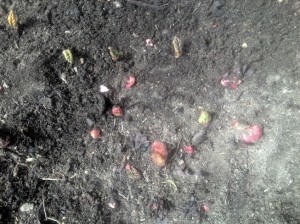
I knew they’d arrive soon and the other day, I saw the first rhubarb sprouting out of the cool soil beside our barn. Most were just thumb sized nubbins of pink but some featured a tiny leaves curled in on themselves like a baby’s fist. The first harvest is still weeks away but rhubarb is my bellwether for spring. The crocus and snowdrops have been up for some time but they all too often poke up too soon and get themselves nipped by the last blasts of winter. There are perils to being an “early adopter.” The daffodils and paperwhites that we’ve naturalized in our front lawn have also started to emerge but for some reason, it’s rhubarb, that sour, old-timey “pie plant” that most truly means spring.
But age has not made me any less impatient. In fact, I feel particularly eager for that first bite of rhubarb pie, that tart tart, and I endeavored to hasten its arrival. We’re all familiar with forcing bulbs by simulating the conditions of spring in advance of its general arrival, in order to coax blossoms. I’ve heard of a similar technique for rhubarb. Jan and I placed one of our home-made cold frames over two clumps of the crowning rhubarb in hopes of creating more balmy conditions for them. The area is already a protected spot, bathed in full southern exposure sunlight and banked on the north by the cement foundation of the barn. The cold frame, we hope, will provide a micro climate just slightly in advance of the rest of the garden by protecting the sprouts from cold air while still providing encouragement from the sun.
It’s an experiment and all good experiments carry the possibility for “failure.” We’ll keep you informed how this test progresses so we all can learn. And maybe I’ll even share a bite of that rhubarb pie!


